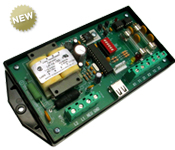Pulse Data from AMI Meters now a Reality
February 2016
|
Many times in commercial energy management projects, it’s difficult or just about impossible to get KYZ pulses from the meter. This can be because of the proximity of the meter to the building, the cost or delay of getting a KYZ output installed, or any number of additional factors involved with monitoring energy use and demand. Solid State Instruments, in following with our philosophy of helping customers solve KYZ pulse metering problems, has created another great tool for energy management contractors and utilities to solve this problem. | |
But first a little background...A trend in the utility industry for several years has been the use of AMI deployments – that is, the implementation of AMI meters across the utilities’ service territories and the communications systems to connect all of these meters with the utility for meter reading, interval data recording, outage notification and other future purposes. AMI implementations started with residential meters, but now it’s rapidly making its way into commercial and industrial meters. Depending on the specific utility, AMI meters are often equipped with Zigbee radios for the future home area networks (HAN’s) and other envisioned customer- use applications. While in a lot of ways this is a “technology in search of a paying market” for the residential customer segment, SSI has discovered a valuable real-world application employing this technology for commercial and industrial customers. |
|
Here is the problem SSI is trying to solveOne of the complaints that we periodically hear from commercial and industrial customers with energy management systems is that when the utility installs the AMI meter on the customer’s building, the customer no longer can receive their KYZ pulses from the meter since most AMI meters have no pulse output. From the utility side, the complaint is that the utilities generally don’t want to leave a non-standard (“old”) meter installed in the field. When this happens, the old meter generally requires a monthly meter reading in person by utility personnel. In addition, having a non-standard meter in the field is problematic for long term support. The solution to all of these problems is SSI’s new MPG-1 Wireless Meter Pulse Generator. The MPG-1 receives regular Zigbee HAN transmissions from the AMI meter that it is paired with, giving demand information at regular intervals. Calculations are done “on the fly” to recreate kWh pulses equivalent to the demand information. The customer can continue to get their pulses for their energy management systems and the utility can now have their AMI meter installed and get rid of the old meter which eliminates monthly in-person meter reading. Another side benefit of getting the power monitoring information this way is the customer or their energy management contractor does not have to install ANY equipment installed at the meter or be directly connected to the meter in any way, saving a time and money. The information is wirelessly sent to the MPG-1’s Zigbee radio receiver which conveys the information to the MPG-1 approximately every 8 to 10 seconds. Energy use information is calculated and pulses are created to emulate a direct KYZ pulse output on the electric meter. This solves the problem of getting pulses from a meter mounted on a utility pole or on a pad-mounted transformer across a driveway or some other remote location that is not in or on the building. The MPG-1 has the option of having pulses outputted in either a Form C “toggle” mode or a Form A “momentary” mode. In Form C mode, the pulses are “spread out” across each transmission interval to emulate the 50/50 duty cycle of a normal toggle pulse output of the meter, such that the receiving system can calculate the instantaneous demand or measure kWh received just like if they had a normal pulse output connected to their system. The Form C “Toggle” mode is generally used with systems that are calculating demand from their pulse input, and work better with the 50/50 duty cycle. Either 2-Wires (KY or KZ) or 3-Wires (KYZ) can be used on the MPG-01’s standard Form C outputs for the destination (receiving) device. This mode is recommended for energy and demand management systems. The Form A “Momentary” mode is generally for energy recording systems that are only interested in kWh use over an interval, and are not calculating instantaneous demand. Pulses are outputted on the KY outputs only for a specific pulse width time. Pulse widths can be set at 100 mS to 1 second in one of 4 steps. This is perfect for recorders, or other instrumentation. Learn more about the MPG-1 Wireless Meter Pulse Generator or
| |

